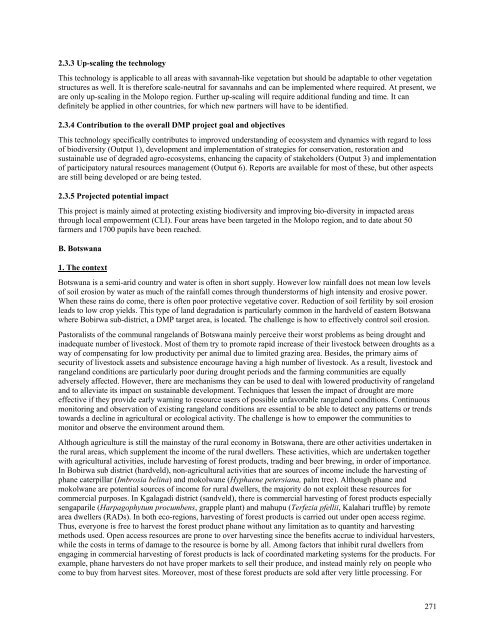ICRISAT Archival Report 2006 - The seedlings of success in the ...
ICRISAT Archival Report 2006 - The seedlings of success in the ...
ICRISAT Archival Report 2006 - The seedlings of success in the ...
You also want an ePaper? Increase the reach of your titles
YUMPU automatically turns print PDFs into web optimized ePapers that Google loves.
2.3.3 Up-scal<strong>in</strong>g <strong>the</strong> technology<br />
This technology is applicable to all areas with savannah-like vegetation but should be adaptable to o<strong>the</strong>r vegetation<br />
structures as well. It is <strong>the</strong>refore scale-neutral for savannahs and can be implemented where required. At present, we<br />
are only up-scal<strong>in</strong>g <strong>in</strong> <strong>the</strong> Molopo region. Fur<strong>the</strong>r up-scal<strong>in</strong>g will require additional fund<strong>in</strong>g and time. It can<br />
def<strong>in</strong>itely be applied <strong>in</strong> o<strong>the</strong>r countries, for which new partners will have to be identified.<br />
2.3.4 Contribution to <strong>the</strong> overall DMP project goal and objectives<br />
This technology specifically contributes to improved understand<strong>in</strong>g <strong>of</strong> ecosystem and dynamics with regard to loss<br />
<strong>of</strong> biodiversity (Output 1), development and implementation <strong>of</strong> strategies for conservation, restoration and<br />
susta<strong>in</strong>able use <strong>of</strong> degraded agro-ecosystems, enhanc<strong>in</strong>g <strong>the</strong> capacity <strong>of</strong> stakeholders (Output 3) and implementation<br />
<strong>of</strong> participatory natural resources management (Output 6). <strong>Report</strong>s are available for most <strong>of</strong> <strong>the</strong>se, but o<strong>the</strong>r aspects<br />
are still be<strong>in</strong>g developed or are be<strong>in</strong>g tested.<br />
2.3.5 Projected potential impact<br />
This project is ma<strong>in</strong>ly aimed at protect<strong>in</strong>g exist<strong>in</strong>g biodiversity and improv<strong>in</strong>g bio-diversity <strong>in</strong> impacted areas<br />
through local empowerment (CLI). Four areas have been targeted <strong>in</strong> <strong>the</strong> Molopo region, and to date about 50<br />
farmers and 1700 pupils have been reached.<br />
B. Botswana<br />
1. <strong>The</strong> context<br />
Botswana is a semi-arid country and water is <strong>of</strong>ten <strong>in</strong> short supply. However low ra<strong>in</strong>fall does not mean low levels<br />
<strong>of</strong> soil erosion by water as much <strong>of</strong> <strong>the</strong> ra<strong>in</strong>fall comes through thunderstorms <strong>of</strong> high <strong>in</strong>tensity and erosive power.<br />
When <strong>the</strong>se ra<strong>in</strong>s do come, <strong>the</strong>re is <strong>of</strong>ten poor protective vegetative cover. Reduction <strong>of</strong> soil fertility by soil erosion<br />
leads to low crop yields. This type <strong>of</strong> land degradation is particularly common <strong>in</strong> <strong>the</strong> hardveld <strong>of</strong> eastern Botswana<br />
where Bobirwa sub-district, a DMP target area, is located. <strong>The</strong> challenge is how to effectively control soil erosion.<br />
Pastoralists <strong>of</strong> <strong>the</strong> communal rangelands <strong>of</strong> Botswana ma<strong>in</strong>ly perceive <strong>the</strong>ir worst problems as be<strong>in</strong>g drought and<br />
<strong>in</strong>adequate number <strong>of</strong> livestock. Most <strong>of</strong> <strong>the</strong>m try to promote rapid <strong>in</strong>crease <strong>of</strong> <strong>the</strong>ir livestock between droughts as a<br />
way <strong>of</strong> compensat<strong>in</strong>g for low productivity per animal due to limited graz<strong>in</strong>g area. Besides, <strong>the</strong> primary aims <strong>of</strong><br />
security <strong>of</strong> livestock assets and subsistence encourage hav<strong>in</strong>g a high number <strong>of</strong> livestock. As a result, livestock and<br />
rangeland conditions are particularly poor dur<strong>in</strong>g drought periods and <strong>the</strong> farm<strong>in</strong>g communities are equally<br />
adversely affected. However, <strong>the</strong>re are mechanisms <strong>the</strong>y can be used to deal with lowered productivity <strong>of</strong> rangeland<br />
and to alleviate its impact on susta<strong>in</strong>able development. Techniques that lessen <strong>the</strong> impact <strong>of</strong> drought are more<br />
effective if <strong>the</strong>y provide early warn<strong>in</strong>g to resource users <strong>of</strong> possible unfavorable rangeland conditions. Cont<strong>in</strong>uous<br />
monitor<strong>in</strong>g and observation <strong>of</strong> exist<strong>in</strong>g rangeland conditions are essential to be able to detect any patterns or trends<br />
towards a decl<strong>in</strong>e <strong>in</strong> agricultural or ecological activity. <strong>The</strong> challenge is how to empower <strong>the</strong> communities to<br />
monitor and observe <strong>the</strong> environment around <strong>the</strong>m.<br />
Although agriculture is still <strong>the</strong> ma<strong>in</strong>stay <strong>of</strong> <strong>the</strong> rural economy <strong>in</strong> Botswana, <strong>the</strong>re are o<strong>the</strong>r activities undertaken <strong>in</strong><br />
<strong>the</strong> rural areas, which supplement <strong>the</strong> <strong>in</strong>come <strong>of</strong> <strong>the</strong> rural dwellers. <strong>The</strong>se activities, which are undertaken toge<strong>the</strong>r<br />
with agricultural activities, <strong>in</strong>clude harvest<strong>in</strong>g <strong>of</strong> forest products, trad<strong>in</strong>g and beer brew<strong>in</strong>g, <strong>in</strong> order <strong>of</strong> importance.<br />
In Bobirwa sub district (hardveld), non-agricultural activities that are sources <strong>of</strong> <strong>in</strong>come <strong>in</strong>clude <strong>the</strong> harvest<strong>in</strong>g <strong>of</strong><br />
phane caterpillar (Imbrosia bel<strong>in</strong>a) and mokolwane (Hyphaene petersiana, palm tree). Although phane and<br />
mokolwane are potential sources <strong>of</strong> <strong>in</strong>come for rural dwellers, <strong>the</strong> majority do not exploit <strong>the</strong>se resources for<br />
commercial purposes. In Kgalagadi district (sandveld), <strong>the</strong>re is commercial harvest<strong>in</strong>g <strong>of</strong> forest products especially<br />
sengaparile (Harpagophytum procumbens, grapple plant) and mahupu (Terfezia pfellii, Kalahari truffle) by remote<br />
area dwellers (RADs). In both eco-regions, harvest<strong>in</strong>g <strong>of</strong> forest products is carried out under open access regime.<br />
Thus, everyone is free to harvest <strong>the</strong> forest product phane without any limitation as to quantity and harvest<strong>in</strong>g<br />
methods used. Open access resources are prone to over harvest<strong>in</strong>g s<strong>in</strong>ce <strong>the</strong> benefits accrue to <strong>in</strong>dividual harvesters,<br />
while <strong>the</strong> costs <strong>in</strong> terms <strong>of</strong> damage to <strong>the</strong> resource is borne by all. Among factors that <strong>in</strong>hibit rural dwellers from<br />
engag<strong>in</strong>g <strong>in</strong> commercial harvest<strong>in</strong>g <strong>of</strong> forest products is lack <strong>of</strong> coord<strong>in</strong>ated market<strong>in</strong>g systems for <strong>the</strong> products. For<br />
example, phane harvesters do not have proper markets to sell <strong>the</strong>ir produce, and <strong>in</strong>stead ma<strong>in</strong>ly rely on people who<br />
come to buy from harvest sites. Moreover, most <strong>of</strong> <strong>the</strong>se forest products are sold after very little process<strong>in</strong>g. For<br />
271

















